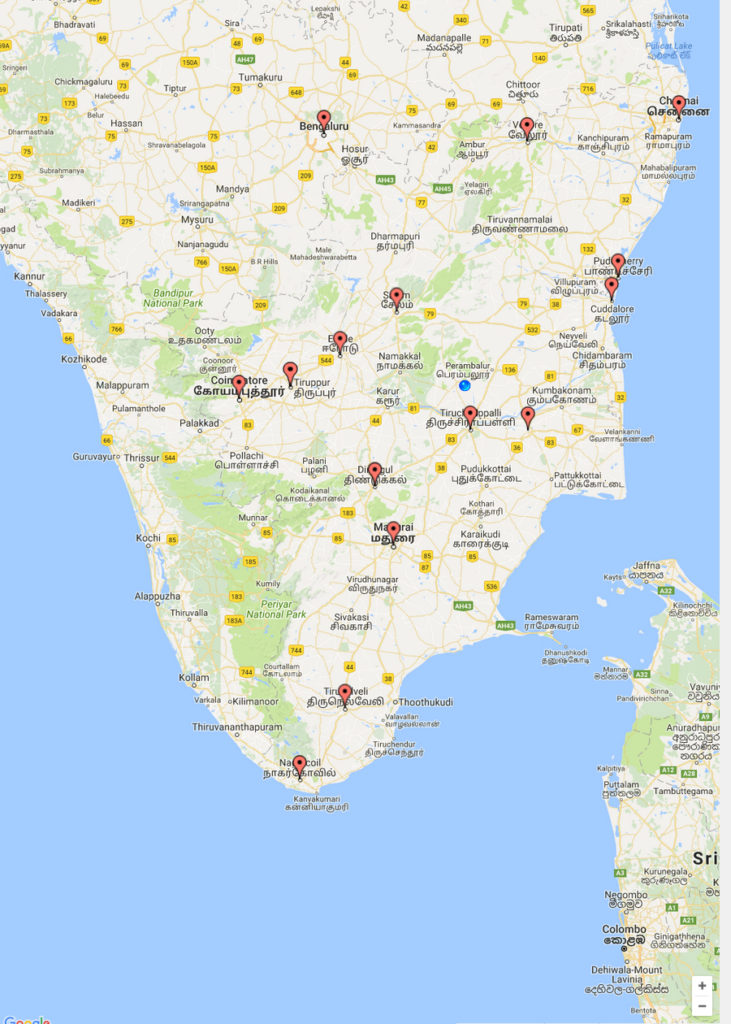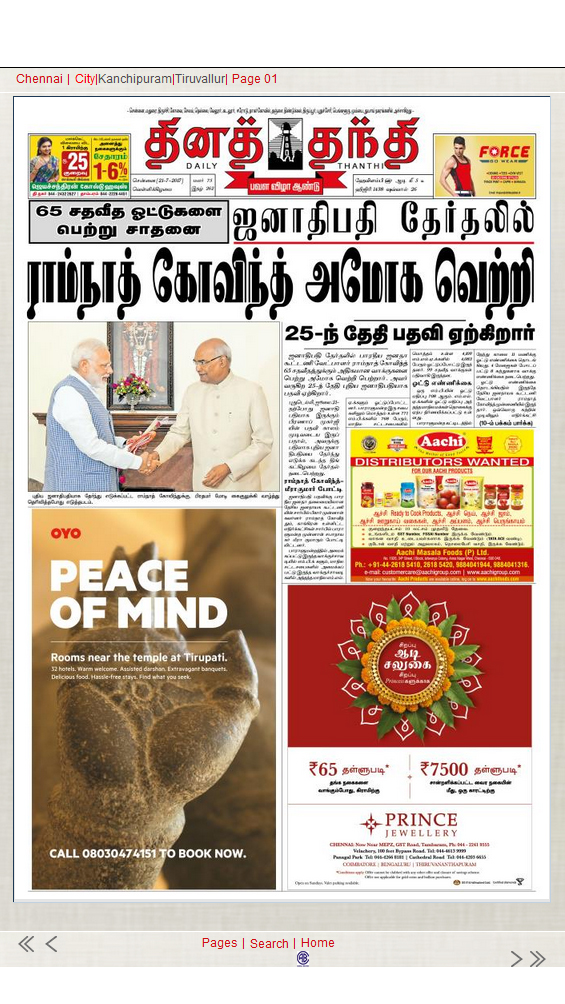Link to video trailer here.

A History of Dina Thanthi: Establishing and creating a new readership in Tamil Nadu
As the state is going into what will be among its most fiercely contested elections later this year, the role that the popular Tamil daily Dina Thanthi and the media group’s other outlets in shaping Tamil readers/ viewers views and opinions become as important as it has ever been in its long history.
Tamil Nadu has a long, enduring history of journalism, beginning with the newspaper, Swadesamitran, which began its print-run in 1882 and continued till 1985. The state has a literacy rate of about 80 per cent at last count, and its people have always been ardent followers of news, especially the newspaper. Tea Kadai or tea shop counters filled with the day’s headlines are commonplace across the state. Even though TV news is as ubiquitous as anywhere else in the country, the newspapers still hold pride of place. This is especially because TV news channels still only offer highly biased and politicised versions of current affairs. It should be noted that news channel ownership is also considered a prerequisite in the arsenal of political parties.
Among the newspapers in Tamil, in Tamil Nadu, the prominent players are Dina Thanthi (which leads the pack in terms of circulation), Dina Mani, Dina Malar, Dinakaran, Tamil Murasu, Makkal Kural, Malai Malar and The Hindu (Tamil).
Among these Dina, Thanthi has been a trendsetter ever since SP Adithanar established it in 1942. The paper currently boasts of 16 editions across Tamil Nadu and India and an edition from Dubai. SP Adithanar, belonging to the Nadar community, studied law in England and the US and practised in Singapore before returning to Tamil Nadu to set up the newspaper.
His most significant contribution was the setting up an in-house newsprint factory when other newspapers were paying significant amounts to 8purchase newsprints from elsewhere. The paper also stood out for its non-Brahmin ownership when the Brahmin community predominantly controlled the industry. Instead of presenting an “intellectual” take on current affairs as many of the pre-independence papers tended to do, Dina Thanthi kept its news and terminologies simple.
Athithanar aimed at developing a subscriber base of those who are not fervent readers but of the more common citizenry who are literate enough to read the newspaper. He even went so far as to create a special dictionary for the paper itself, the Ithazhazhar Kaiyedu (A newspaper man’s guide), where he specified the colloquial terminologies to be used to avoid estranging their readership by using complicated words. The paper is also known for its use of onomatopoeia in its large font headlines.
For example, when reporting on a stabbing, it would be common to see headlines such as the following:
“sadak, sadak enru kathi koothu,” which is an onomatopoeic expression roughly translating to “slash, slash he got stabbed”.
Dina Thanthi, with its nearly eight-decade history, is notable for practising a distinct editorial style. The paper also has reporters stationed in all district headquarters and employs stringers extensively across the state.

The contemporary scenario
Dina Thanthi and the Thanthi group is now in their third generation of ownership. After SP Adhithanar, the reigns of the newspaper empire were handed over to his son, Sivanthi Athithan. The latter followed in his father’s footsteps regarding the newspaper’s politics, style and content. He also established the Maalai Malar in 1959, which was Tamil Nadu’s first evening daily. Following his stepping down in 2005, his son S Balasubramaniam Adityan has been in charge of the business and taking it forward into the future.
Thanthi TV (A 24-hour news channel) and DT Next, an English supplement that accompanies the Tamil daily, were set up in recent years. While the paper retains its populist flavours, there are significant changes in its editorial style.
As things stand now, Dina Thanthi still retains its large circulation figures. The media group, especially the newspaper, still largely works on the tried and tested formulae of running a regional media empire as prescribed by SP Athithanar.
The Dravidian movement and Thanthi
When Dina Thanthi began its print-run in 1942, a strong Dravidian movement with EV Ramasamy or Periyar at the helm was sweeping across the state. The figureheads of the Dravidian movements were taking baby steps into electoral politics and needed taking their message and propaganda to the people then, more than ever.
Periyar was the president of the Justice Party from 1938 to 1944 and went onto establish the Dravidar Kazhagam (Dravidian Party) in 1944. The Dravida Munnetra Kazhagam (DMK) was also established by Periyar’s protégé CN Annadurai towards the end of the decade. This was also the time when there were strong anti-Hindi sentiments in the state.
The Tamil newspapers present at the time, regardless of being sympathetic or antithetic to the ideologies of the Dravidian movement, had little to no readership outside the Tamil intelligentsia. It was this gaping vacuum that Thanthi filled. SP Athithanar, apart from keeping the goings-on of the Dravidian movement and Periyar at the forefront of his newspaper’s priorities, also established his political outfit a couple of decades later, calling it Naam Tamilar Katchi (We are Tamils Party).
As Arunachalam Mari Sami, 81, who worked at the Thanthi from 1954 till 2007, recounts, “I was based in Tiruchi then and Periyar used to come to town often, staying at the Periyar Maligai.” Sami was the Editor of the newspaper from 1958 to 1962 and then went on to be the Editor of their popular weekly magazine, Rani, for the next four and a half decades. He adds, “I used to interview him often and was encouraged to travel with him across the state as well. At Thanthi, he and the party were highly respected, and we looked to give them as much coverage as possible then.”
Thanthi, whose news style was inspired by that of the Daily Mirror in England, proved useful in developing a cadre-based for the Dravidian parties. Being the first paper to be printed in various towns across the state, people were, for the first time, delivered immediate news and didn’t have to wait for day-old newspapers that were printed in Madras (Chennai) to reach them. Its simple language style was easy to read and follow and many in the state, who had a cursory education, learnt and developed their Tamil reading skills through the Thanthi.
A voice for the non-Brahmins
The Thanthi was also the first newspaper that directly challenged the dominance of the Brahmin community in the Tamil media landscape. In the 1940s, the other Tamil newspapers, such as the Dina Mani and Swadesamitran, were decidedly under Brahmin leadership. SP Athithanar, who belongs to the Nadar community, was the first media-figurehead to emerge from another community. Since Kayamozhi had a significant Muslim population, many from the community were also hired and offered editorial and non-editorial positions at the Thanthi.
Athithanar predominantly hired from his community, especially his village of Kayamozhi in the Tuticorin district. While their hiring practises were questionable (details of which will be discussed in a later chapter), this developed an editorial team that was completely non-Brahmin.
Their approach to information-gathering, analysis and news priorities were significantly different because of this. With the Tamil language movement growing, the paper and the movement worked well, almost like a symbiotic relationship – with each feeding into the other and helping their respective reach and organizations grow.
***
Sibi Arasu is an independent journalist based in Bangalore. He writes primarily on environmental issues and climate change. He has worked as a journalist for more than a decade and has written for several leading Indian and international publications, including the BBC, Hakai Magazine, Caravan magazine, The Hindu, The Times of India, and the Hindustan Times among others.
Link to the first part here.
[…] Link to the second part here. […]
… [Trackback]
[…] Read More Infos here: doingsociology.org/2021/03/13/tamil-nadus-daily-mail-pioneering-mass-media-in-tamil-nadu-and-india-a-case-study-of-the-popular-tamil-daily-dina-thanthi-sibi-arasu/ […]
Thank you for sharing your personal experience and wisdom with us Your words are so encouraging and uplifting
Your blog post was fantastic, thanks for the great content!
Your positivity and optimism are contagious It’s evident that you genuinely care about your readers and their well-being
This blog is a great resource for anyone looking to live a more mindful and intentional life Thank you for providing valuable advice and tips
I am constantly impressed by the depth and detail in your posts You have a gift for making complex topics easily understandable
This blog is like a virtual mentor, guiding me towards personal and professional growth Thank you for being a source of inspiration
I have been struggling with this issue for a while and your post has provided me with much-needed guidance and clarity Thank you so much
Nice post. I learn something totally new and challenging on websites
Let’s spread the love! Tag a friend who would appreciate this post as much as you did.
From start to finish, this blog post had us hooked. The content was insightful, entertaining, and had us feeling grateful for all the amazing resources out there. Keep up the great work!
Your blog always puts a smile on my face and makes me feel better about the world Thank you for being a source of light and positivity
Your blog has become a source of guidance and support for me Your words have helped me through some of my toughest moments
I want to express my appreciation for the writer of this blog post. It’s clear they put a lot of effort and thought into their work, and it shows. From the informative content to the engaging writing style, I thoroughly enjoyed reading it.
You have a way of making each of your readers feel seen and heard That’s a special quality that not all bloggers possess Thank you for creating a safe space for us
Your content always keeps me coming back for more!
You have a way of making each of your readers feel seen and heard That’s a special quality that not all bloggers possess Thank you for creating a safe space for us
Your posts are so beautifully written and always leave me feeling inspired and empowered Thank you for using your talents to make a positive impact
I have been struggling with this issue for a while and your post has provided me with much-needed guidance and clarity Thank you so much
I appreciate the effort that goes into creating high-quality content, and this post was no exception. The insights and information were top-notch and made for a really engaging read. Keep up the great work!
The topics covered here are always so interesting and unique Thank you for keeping me informed and entertained!
Your knowledge and expertise on various topics never ceases to amaze me I always learn something new with each post
Thank you for the amazing blog post!
From the bottom of my heart, thank you for being a source of positivity and light in this sometimes dark and overwhelming world
Let’s spread the love! Tag a friend who would appreciate this post as much as you did.
Tamil Nadu’s Daily Mail: Pioneering Mass Media in Tamil Nadu and India explores the significant impact of media, much like the vibrant creativity of Vax’ildan cosplay. Just as Vax’ildan’s character embodies unique storytelling and imagination, the daily Dina Thanthi has played a crucial role in shaping public discourse and culture in Tamil Nadu. Both highlight the importance of representation and expression, encouraging individuals to engage with their communities and share their narratives, whether through media or creative cosplay